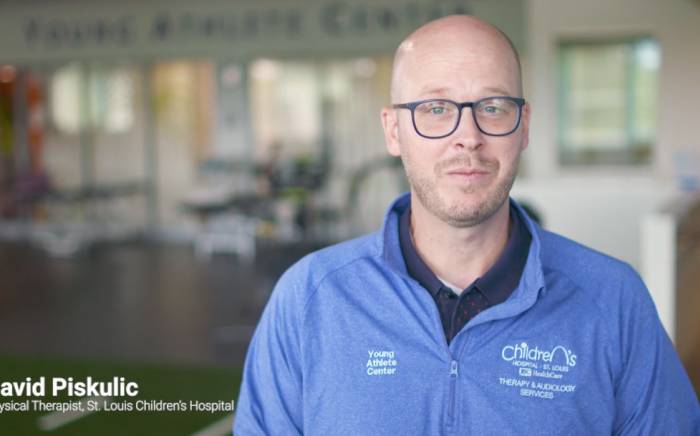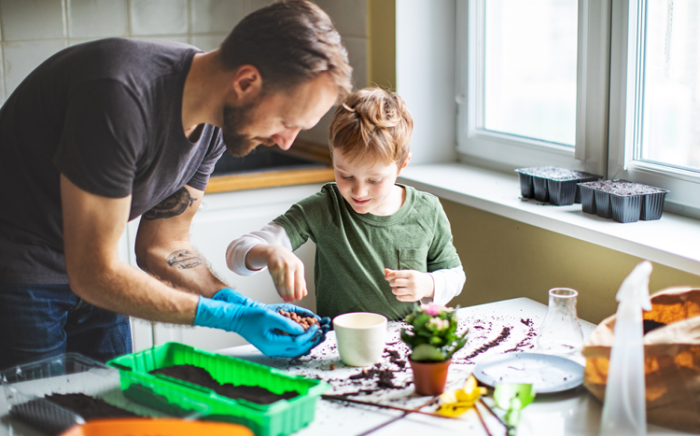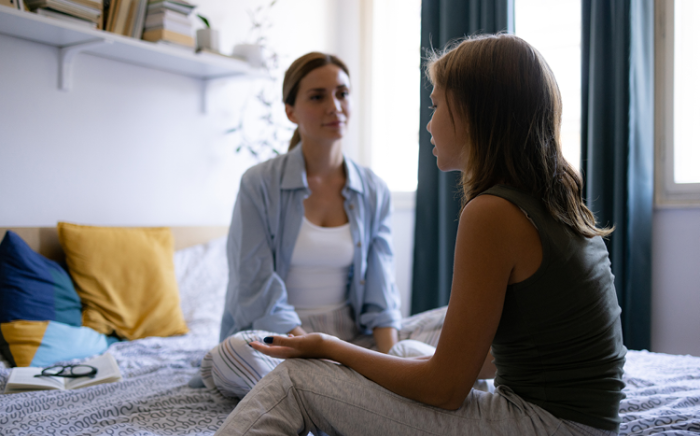Overview
Rhabdomyosarcoma is a type of cancer. It starts in cells that grow into skeletal muscle cells. Skeletal muscles control all of a person’s voluntary muscle movements. The cancer is most common in children under age 10, but it is rare. It can form anywhere in the body. The most common places are:
- Head and neck, such as near an eye, in the throat, or in the sinuses
- Urinary and reproductive organs, such as the bladder, prostate gland, or any female organs
- Arms and legs
- Chest and belly (abdomen)
For more information regarding rhabdomyosarcoma services in St. Louis, please call 314.454.5437 or 800.678.5437 or email us.
There are 2 main types of rhabdomyosarcoma:
- Embryonal. This is the most common type. It’s more common in younger children.
- Alveolar. This is more common in older children and teenagers. This type grows more quickly. It’s more likely to spread to other areas of the body (metastasize).
Causes
The exact cause of rhabdomyosarcoma is not known. Changes in the genetic material in cells (DNA) may cause the cells to turn into cancer.
Risk Factors
Some health conditions that are passed down through families (genetic) increase a child's risk. These include:
- Li-Fraumeni syndrome
- Neurofibromatosis
- Beckwith-Wiedemann syndrome
- Costello syndrome
Symptoms
Symptoms depend on the location and the size and of the tumor. There may be no symptoms until the tumor is very large. The main symptom may be a lump or swelling that may be painful. Other symptoms can occur a bit differently in each child.
A growth near the eye can cause:
- Bulging eye or the eyes seem to be crossed
- Trouble with vision
A growth in the ear or sinuses can cause:
- Ear pain
- Headache
- Sinus congestion
A growth in the urinary or reproductive organs can cause:
- Bleeding
- Pain when urinating
- Pain with bowel movements
A growth in the abdomen can cause:
- Pain
- Vomiting
- Trouble having bowel movements (constipation)
Symptoms of advanced rhabdomyosarcoma may include:
- Bone pain
- Constant cough
- Weakness
- Weight loss
The symptoms of rhabdomyosarcoma can be like other health conditions. Make sure your child sees a healthcare provider for a diagnosis.
Diagnosis
Your child's healthcare provider will ask about your child's health history and symptoms. He or she will examine your child. Your child may be referred to a child cancer specialist (pediatric oncologist). Your child may have tests such as:
- Blood and urine tests. Blood and urine are tested in a lab.
- X-ray. An X-ray uses a small amount of radiation to take pictures of bones and other body tissues.
- CT scan. This test uses a series of X-rays and a computer to make detailed images of the body.
- MRI. This test uses large magnets, radio waves, and a computer to make detailed images of the inside of the body.
- Ultrasound (sonography). This test uses sound waves and a computer to create images.
- Bone scan. A small amount of dye is injected into a vein. The whole body is scanned. The dye shows up in areas where there may be cancer.
- Positron emission tomography (PET) scan. For this test, a radioactive sugar is injected into the bloodstream. Cancer cells use more sugar than normal cells, so the sugar will collect in cancer cells. A special camera is used to see where the radioactive sugar is in the body. A PET scan can sometimes spot cancer cells in different areas of the body, even when they can’t be seen by other tests. This test is often used in combination with a CT scan. This is called a PET/CT scan.
- Tumor biopsy. A sample of the tumor is taken. It may be taken with a needle or by a surgical cut (incision). It is checked under a microscope for cancer cells. A biopsy is the only way to know for sure if the tumor is cancer.
- Bone marrow aspiration or biopsy. Bone marrow is found in the center of some bones. It’s where blood cells are made. A small amount of bone marrow fluid may be taken. This is called aspiration. Or solid bone marrow tissue may be taken. This is called a core biopsy. Bone marrow is usually taken from the hip bone. This test may be done to see if cancer cells have reached the bone marrow.
- Lumbar puncture. A special needle is placed into the lower back, into the spinal canal. This is the area around the spinal cord. This is done to check the brain and spinal cord for cancer cells. A small amount of cerebral spinal fluid (CSF) is removed and sent for testing. CSF is the fluid around the brain and spinal cord. This test may be done for rhabdomyosarcoma of the head and neck.
Part of diagnosing cancer is called staging. Staging is the process of seeing if the cancer has spread, and where it has spread. Staging also helps to decide the treatment. There are different ways of staging cancer, but most range from stage 1 to stage 4. Talk with your child's healthcare provider about the stage of your child's cancer and what it means.
Treatment
Treatment will depend on the location, stage, and other factors. The cancer can be treated with any of the below:
- Surgery. The goal of surgery is to fully remove the tumor. This is called resection. The surgery will be done to avoid loss of function and deformation as possible. A surgeon who specializes in the body area of tumor growth may be needed. This may be a head and face (craniofacial) surgeon, or an ear, nose, and throat (otolaryngologist) doctor. It may be a brain surgeon (neurosurgeon) or bone doctor (orthopedist). Or it may be another type of doctor.
- Chemotherapy. These are medicines that kill cancer cells. They are always used to treat rhabdomyosarcoma. Some medicines may be given by mouth. But most are given through a vein (IV).
- Radiation therapy. These are high-energy X-rays or other types of radiation. Radiation is used to kill cancer cells or stop them from growing. It may be used when a tumor is hard to remove with surgery. Radiation therapy is usually given along with chemotherapy.
- Clinical trials. Ask your child's healthcare provider if there are any treatments being tested that may work well for your child.
- Supportive care. Treatment can cause side effects. Medicines and other treatments can be used for pain, fever, infection, and nausea and vomiting.
With any cancer, the chances of a cure (prognosis) depend on a number of things. Keep in mind:
- Getting medical treatment right away is important for the best prognosis. Cancer that has spread is harder to treat.
- Ongoing follow-up care during and after treatment is needed.
- New treatments are being tested to improve outcome and to lessen side effects.
Complications
A child may have complications from the tumor or from treatment. Complications depend on where the tumor is and the treatments needed. They may include:
- Damage to the brain or nervous system that causes problems with coordination, muscle strength, speech, or eyesight
- Problems after surgery, such as infection, bleeding, and problems with general anesthesia
- Infection and bleeding from chemotherapy
- Delayed growth and development
- Learning problems
- Problems with reproduction (infertility)
- Return of the cancer
- Growth of other cancers
Living with
A child with rhabdomyosarcoma needs ongoing care. Your child will be seen by oncologists and other healthcare providers to treat any late effects of treatment and to watch for signs or symptoms of the tumor returning. Your child will be checked with imaging tests and other tests. And your child may see other healthcare providers for problems from the tumor or from treatment. For example, your child may see an eye doctor (ophthalmologist) for vision problems.
Your child may need therapy to help with movement and muscle strength. This may be done by physical and occupational therapists. If your child's speech is affected, he or she may need help from a speech therapist. Your child may also need the help of other therapists for learning or emotional problems.
You can help your child manage his or her treatment in many ways. For example:
- Your child may have trouble eating. A dietitian may be able to help.
- Your child may be very tired. He or she will need to balance rest and activity. Encourage your child to get some exercise. This is good for overall health. And it may help to lessen tiredness.
- Get emotional support for your child. Find a counselor or child support group can help.
- Make sure your child attends all follow-up appointments.
When to Call a Healthcare Provider
Call the healthcare provider if your child has:
- Symptoms that get worse
- New symptoms
- Side effects from treatment
Key Points
- Rhabdomyosarcoma is a rare type of cancer that starts in the cells that develop into skeletal muscle cells.
- It can occur almost anywhere in the body. The most common places are the head and neck; urinary and reproductive organs; arms and legs; and chest and belly (abdomen).
- Symptoms depend on the size and the location of the tumor. A lump or swelling, pain, bleeding, trouble urinating or having bowel movement are some symptoms.
- Tests include different imaging studies and biopsy of the tumor.
- Treatment includes surgery, chemotherapy, and sometimes radiation therapy.
- Ongoing follow-up care during and after treatment is needed.
Next Steps
Tips to help you get the most from a visit to your child’s healthcare provider:
- Before your visit, write down questions you want answered.
- At the visit, write down the names of new medicines, treatments, or tests, and any new instructions your provider gives you for your child.
- If your child has a follow-up appointment, write down the date, time, and purpose for that visit.
- Know how you can contact your child’s provider after office hours. This is important if your child becomes ill and you have questions or need advice.
For more information regarding rhabdomyosarcoma services in St. Louis, please call 314.454.5437 or 800.678.5437 or email us.








